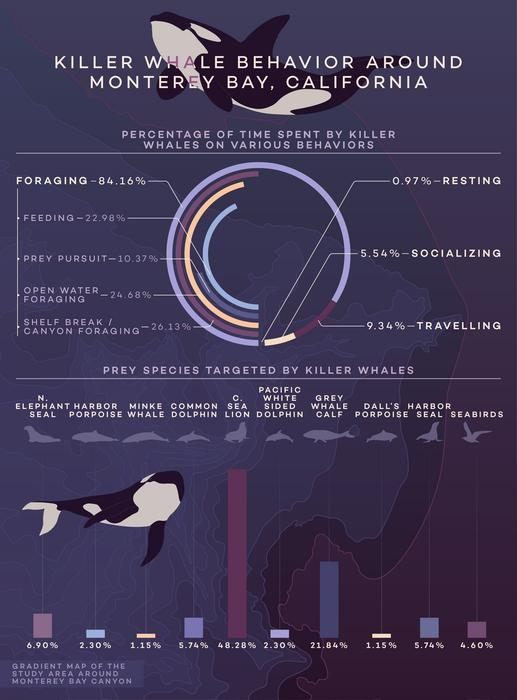Josh McInnes and colleagues from the University of British Columbia report in the open-access journal PLOS ONE that killer whales hunting in deep submarine canyons off the coast of California form a unique subpopulation. They employ specialized hunting methods to capture marine mammals.
 Researchers observed how transient killer whales (orcas) in Monterey Bay, California spent their time through 270 hours of behavioral observations. Foraging accounted for 84.16% of the time spent by orcas, with other activities including traveling, socializing, and resting. Additionally, this study presents the main targeted prey species: mostly California sea lions, and grey whale calves. The findings provide insights into predator-prey interactions in this submarine canyon/deep-water environment. Image Credit: Infographic by Anne-Lise Paris, PLOS.
Researchers observed how transient killer whales (orcas) in Monterey Bay, California spent their time through 270 hours of behavioral observations. Foraging accounted for 84.16% of the time spent by orcas, with other activities including traveling, socializing, and resting. Additionally, this study presents the main targeted prey species: mostly California sea lions, and grey whale calves. The findings provide insights into predator-prey interactions in this submarine canyon/deep-water environment. Image Credit: Infographic by Anne-Lise Paris, PLOS.
Although killer whales (Orcinus orca) can be found in oceans all over the world, they exist in distinct populations, or “ecotypes,” each with its social structure, dietary habits, and hunting techniques. Transient killer whales are one ecotype whose primary prey is marine mammals. There are two groups within this ecotype: inner coast whales, which feed in shallow coastal waters, and outer coast whales, which hunt in deep water.
Of the two groups, the outer coast whales are comparatively poorly understood. The foraging habits of transient outer coast killer whales around Monterey Submarine Canyon, California, have been studied by researchers using data from marine mammal surveys undertaken between 2006 and 2018 and whale-watching ecotours conducted between 2014 and 2021.
This subpopulation mostly preyed on northern elephant seals, grey whale calves, and California sea lions; members were only observed in open waters. In open water, where prey is more difficult to corner, they hunt using specialized techniques. They frequently used their tail to strike or propel sea lions into the air, as well as to batter their prey unconscious with forceful blows to the head or body.
The researchers distinguished between two primary categories of foraging behavior: loosely organized groups that followed the shapes of the underwater canyons, and dispersed groups that dove freely in the open water.
According to these findings, there is a distinct subpopulation of outer coast whales that have adapted specific hunting strategies to capture marine mammals in this deep-water environment. The authors speculate that their unique foraging practices could be passed down culturally from one generation to the next.
The authors added: “Transient (mammal-hunting) killer whales have been studied primarily in coastal shallow water habitats, and there is currently little known regarding their behavior in offshore and deep pelagic systems. This study highlights the complex foraging behavior and ecology of transients, and how they act as apex predators in productive deep submarine canyon systems, and how their behavior is linked to multiple marine mammal prey populations in the North Pacific Ocean.”
Source:
Journal reference:
McInnes, D., J., et al. (2024) Foraging behavior and ecology of transient killer whales within a deep submarine canyon system. PLOS ONE. doi.org/10.1371/journal.pone.0299291